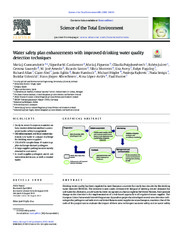Приказ основних података о документу
Water safety plan enhancements with improved drinking water quality detection techniques
| dc.creator | Gunnarsdottir, Maria J. | |
| dc.creator | Gardarsson, Sigurdur M. | |
| dc.creator | Figueras, Maria J. | |
| dc.creator | Puigdomenech, Claudia | |
| dc.creator | Juarez, Ruben | |
| dc.creator | Saucedo, Gemma | |
| dc.creator | Jose Arnedo, M. | |
| dc.creator | Santos, Ricardo | |
| dc.creator | Monteiro, Silvia | |
| dc.creator | Avery, Lisa | |
| dc.creator | Pagaling, Eulyn | |
| dc.creator | Allan, Richard | |
| dc.creator | Abel, Claire | |
| dc.creator | Eglitis, Janis | |
| dc.creator | Hambsch, Beate | |
| dc.creator | Huegler, Michael | |
| dc.creator | Rajković, Andreja | |
| dc.creator | Šmigić, Nada | |
| dc.creator | Udovički, Božidar | |
| dc.creator | Albrechtsen, Hans-Jorgen | |
| dc.creator | Lopez-Aviles, Alma | |
| dc.creator | Hunter, Paul | |
| dc.date.accessioned | 2020-12-17T22:55:50Z | |
| dc.date.available | 2020-12-17T22:55:50Z | |
| dc.date.issued | 2020 | |
| dc.identifier.issn | 0048-9697 | |
| dc.identifier.uri | http://aspace.agrif.bg.ac.rs/handle/123456789/5360 | |
| dc.description.abstract | Drinking water quality has been regulated in most European countries for nearly two decades by the drinking water directive 98/83/EC. The directive is now under revision with the goal of meeting stricter demands for safe water for all citizens, as safe water has been recognized as a human right by the United Nations. An important change to the directive is the implementation of a risk-based approach in all regulated water supplies. The European Union Framework Seventh Programme Aquavalens project has developed several new detection technologies for pathogens and indicators and tested them in water supplies in seven European countries. One of the tasks of the project was to evaluate the impact of these new techniques on water safety and on water safety management. Data were collected on risk factors to water safety for five large supplies in Denmark, Germany, Spain and the UK, and for fifteen small water supplies in Scotland, Portugal and Serbia, via a questionnaire aiming to ascertain risk factors and the stage of implementation of Water Safety Plans, and via site-specific surveys known as Sanitary Site Inspection. Samples we re collected from the water supplies from all stages of water production to delivery. Pathogens were detected in around 23% of the 470 samples tested. Fecal contamination was high in raw water and even in treated water at the small supplies. Old infrastructure was considered a challenge at all the water supplies. The results showed that some of the technique, if implemented as part of the water safety management, can detect rapidly the most common waterborne pathogens and fecal pollution indicators and therefore have a great early warning potential; can improve water safety for the consumer; can validate whether mitigation methods are working as intended; and can confirm the quality of the water at source and at the tap. | en |
| dc.publisher | Elsevier, Amsterdam | |
| dc.relation | info:eu-repo/grantAgreement/EC/FP7/311846/EU// | |
| dc.rights | openAccess | |
| dc.source | Science of the Total Environment | |
| dc.subject | Drinking water safety | en |
| dc.subject | Water safety plan performance | en |
| dc.subject | Risk factors in water supply | en |
| dc.title | Water safety plan enhancements with improved drinking water quality detection techniques | en |
| dc.type | article | |
| dc.rights.license | ARR | |
| dc.citation.other | 698: - | |
| dc.citation.rank | aM21 | |
| dc.citation.volume | 698 | |
| dc.identifier.doi | 10.1016/j.scitotenv.2019.134185 | |
| dc.identifier.fulltext | http://aspace.agrif.bg.ac.rs/bitstream/id/3856/5357.pdf | |
| dc.identifier.scopus | 2-s2.0-85071870878 | |
| dc.identifier.pmid | 31505354 | |
| dc.identifier.wos | 000500580700043 | |
| dc.type.version | publishedVersion |


